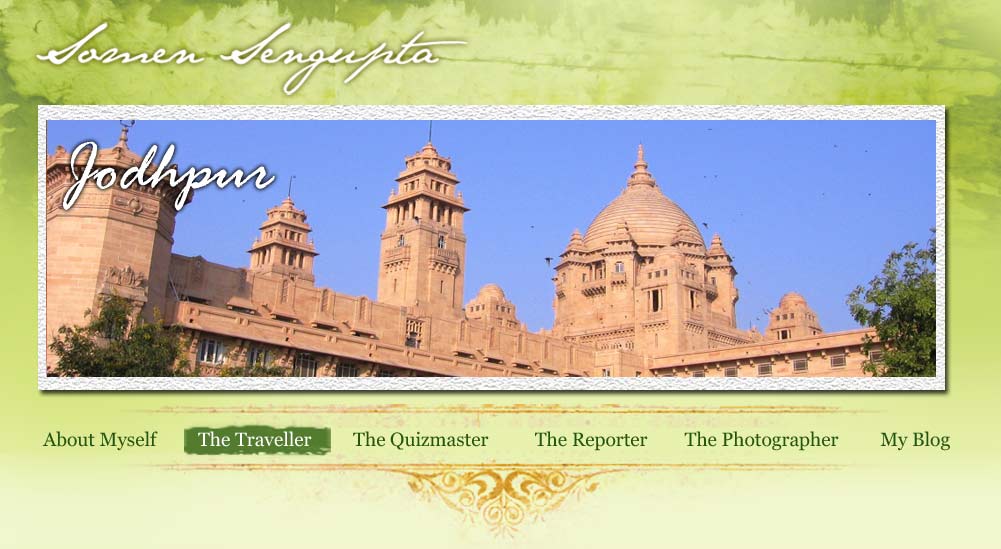| JODHPUR, THE ROYAL SEAT OF SUN |
|
The blue city is one of the supreme samples of India’s royal and elegant past. In its narrow lanes, the edifice of a pristine past silently whispers with contemporary time, says Somen Sengupta
For many centuries, Jodhpur has been the hub of Marwar, meaning the land of the dead. The infertile land with rare rainfall made the area a death bed for men and animals for many years. However, the harsh climate could not diminish the spirit of its people. They made Jodhpur one of the biggest royal kingdoms of India and contributed richly to the country’s art, commerce, music, food and mostly architecture. Its sons of the soil, known as Marwaris, migrated across India and earned extraordinary fortune in business.
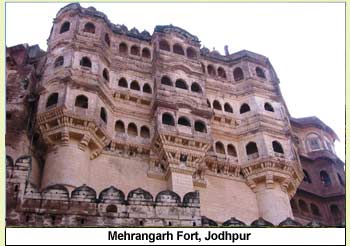 Today, the city of Jodhpur is home to archaeological gems from a different era. The Mehrangarh Fort boasts of a rich history and splendid architecture. The word Mehrangrah came from Mihir garh, meaning the abode of Sun. The history of the fort goes hand by hand with the history of Jodhpur city — the second biggest in Rajasthan and perhaps the most spectacular tourist spot India has to offer. Today, the city of Jodhpur is home to archaeological gems from a different era. The Mehrangarh Fort boasts of a rich history and splendid architecture. The word Mehrangrah came from Mihir garh, meaning the abode of Sun. The history of the fort goes hand by hand with the history of Jodhpur city — the second biggest in Rajasthan and perhaps the most spectacular tourist spot India has to offer.
An extraordinary 550-year-old fort stands in one corner, while the last modern palace of colonial India exists elegantly on the other. In 1211, Rathore Rajput fled his old capital Mandore to take refuge in Marwar. From then started a royal saga, and finally on May 12, 1459, one Pradhan Rao Maldeo Jodha established a royal fort atop Godagiri mountain. The fort situated 400 ft above the city surface was called the abode of Sun.
Legend has it that a man named Raja Ram Meghwal was buried alive at the time of its foundation to mark a sacred sacrifice to God. Even the architect of the fort was buried alive to keep its design confidential. Mehrangarh got its real glory during the period of Maharaja Yashwant, who ruled Marwar from 1638 to 1678. Later, it was attacked and conquered by Afghan ruler Shershah, who demolished the temple inside the fort.
In the 16th century, Rao Udai Singh regained it. It was he who played a significant diplomatic role with Mughal emperor Akbar and saved the kingdom from Mughal accession. Through marriage diplomacy, he made his daughter a Hindu queen of Prince Jehangir, who went on to become Jodhabai of the Mughal harem. It cemented a long term peace treaty with the Mughals. For this he derived the ‘Raja’ title from the Mughal royal court.
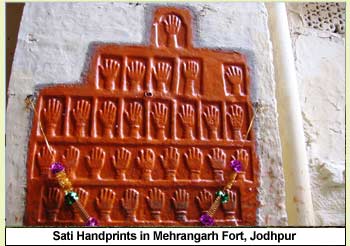 The fort was taken over by Aurangzeb in 1678, but a year after his death in 1708 it was again recovered by Raja Ajit Singh. The Marwar chronicle records that during Ajit Singh’s funeral, his six wives and 58 concubines sacrificed their lives to immortalise themselves as sati, at this fort. The glory of Rajputs did not last long after that. Maratha invaders from Deccan and finally the East India Company got hold of this great fort in 1818. The fort was taken over by Aurangzeb in 1678, but a year after his death in 1708 it was again recovered by Raja Ajit Singh. The Marwar chronicle records that during Ajit Singh’s funeral, his six wives and 58 concubines sacrificed their lives to immortalise themselves as sati, at this fort. The glory of Rajputs did not last long after that. Maratha invaders from Deccan and finally the East India Company got hold of this great fort in 1818.
As I entered the fort crossing the sloped path, the splendour of its design and craftsmanship captivated my attention. The fort has several gates; the gateway of victory, locally known as Fateh pole, was built in 1708. As soon as one crosses the Fateh pole, one can spot an orange slab with palm prints of satis or women who burnt themselves in the pyre of their dead husband, King Ajit Singh, in 1843. Sati cult was officially banned in India in 1829, and from 1818 a British resident was present in Jodhpur, but no one dared stop royal sacrifices of queens and concubines of a dead king.
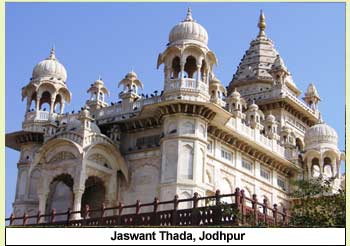 The fort houses a mini township that contains Singar Chowk meant for public weddings. Now divided into 18 parts, it houses a history museum which displays some of the finest antiques of the royal family. The 80-kg coronation throne made of gold by Abhay Singh is now at Moti Mahal. The ceilings and walls are colourfully decorated with local organic colours, sandalwood frames and glass. But even after so many centuries, they shine as bright as new. The fort houses a mini township that contains Singar Chowk meant for public weddings. Now divided into 18 parts, it houses a history museum which displays some of the finest antiques of the royal family. The 80-kg coronation throne made of gold by Abhay Singh is now at Moti Mahal. The ceilings and walls are colourfully decorated with local organic colours, sandalwood frames and glass. But even after so many centuries, they shine as bright as new.
The residential portion of the fort, especially the wall that served as a bridge between the outer and inner world, is crowned with the world’s finest work of jafri carved on sandstone. It is amazing to see how sculptors made the great work possible several years ago when there was no electronic stone cutting machine. Pavilion after pavilion of this fort displays jafri that contains various floral designs and Hindu motifs. The jharokha or the window frame covered with a stone curtain from where women saw the outside world is a sight to behold. With almost zero influence of Islamic architecture, the sandstone work of this fort is distinctive.
The artillery section of the fort has a rich collection, such as the massive canons on the terrace. No one should miss the Chamunda Durga Mandir that enshrines the deity of the royal family. It is believed that it was taken to this fort in 1469 from Mandore. The massive 17.5-kg lock, and the ponds built for queens also attract visitors. From the top of the fort the old city looks like a bustling human jungle where most of the buildings are painted blue. The colour singles out houses of Bramhins, pointing to the strong caste awareness among citizens. No wonder Jodhpur is also known as the blue city.
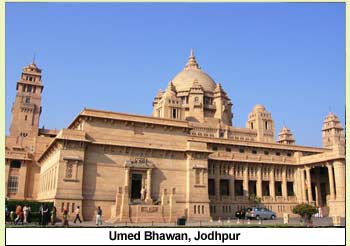 If Mehrangarh is a known gem, then Yashwant Thada is the unknown gem of Jodhpur. This royal mausoleum was established by the queen of Yashbant Singh II ( 1875-1895). Built in 1899, it is the final resting place of the royal family, and their memorials have been erected on the ground. Built in white marble with excellent carving and stonecrafting, these temple-like monuments are a feast for eyes. The place is calm and silence rules here. The temples are small but enriched in decoration. If Mehrangarh is a known gem, then Yashwant Thada is the unknown gem of Jodhpur. This royal mausoleum was established by the queen of Yashbant Singh II ( 1875-1895). Built in 1899, it is the final resting place of the royal family, and their memorials have been erected on the ground. Built in white marble with excellent carving and stonecrafting, these temple-like monuments are a feast for eyes. The place is calm and silence rules here. The temples are small but enriched in decoration.
The next stop is India’s last great palace of the colonial era, the Umaid Bhawan. In the 1920s, when the area witnessed a prolonged period of famine, Maharaja Umaid Singh planned a grand palace construction project which would generate employment to 3,000 people. It was more a job generation project than building a luxury abode. Built in classical Italian style between 1929 and 1942, the palace is the last footprint of a fading class of India. Designed by HV Lanchester and JR Lodges, this pink and golden sandstone palace has 347 rooms with a huge central dome 32 m from floor surface. The inside walls were painted by Polish painter Jullius Stephen Norbin. The building is made of interlocking stone block process and has now been partly thrown open to the public. The part opened to public has been converted into a museum that displays royal collection of commodities and artifacts. The unimaginable collection of clocks, cameras, crockery, royal garments, old photographs, hunting trophies, furniture and vintage cars, ranging from Rolls Royce to Ford, are mind-blowing.
One can’t miss the coaches of Jodhpur Railways — the personally owned railway company of the royal family in the colonial era, which started in 1924 and used to run 2,400 km from Jodhpur to Sindh — are also on display. After India’s Independence in 1947, Jodhpur was initially reluctant to join the Indian republic, but later its ruler Hanwant Singh agreed. Today, Jodhpur prevails as one of the supreme samples of India’s royal and elegant past. In its narrow lanes, the edifice of a pristine past silently whispers with contemporary time.
This article was published on 22nd March 2015 in The Pioneer
Click here to view the original article
|
